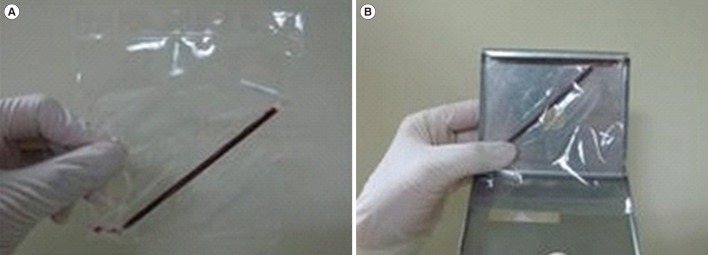Ann Lab Med.
2017 Mar;37(2):124-128. 10.3343/alm.2017.37.2.124.
Long-Term Quality Control Program Plan for Cord Blood Banks in Korea: A Pilot Study for Cryopreservation Stability
- Affiliations
-
- 1Department of Laboratory Medicine, Seoul National University College of Medicine, Seoul, Korea. slice@snu.ac.kr
- 2Department of Laboratory Medicine, Boramae Hospital, Seoul, Korea.
- 3Seoul Metropolitan Government Public Cord Blood Bank (Allcord), Seoul, Korea.
- 4Department of Biostatics, Boramae Hospital, Seoul, Korea.
- 5Department of Obstetrics and Gynecology, Boramae Hospital, Seoul, Korea.
- KMID: 2373629
- DOI: http://doi.org/10.3343/alm.2017.37.2.124
Abstract
- BACKGROUND
Maintaining the quality of cryopreserved cord blood is crucial. In this pilot study, we describe the results of the internal quality control program for a cord blood bank thus far.
METHODS
Donated cord blood units unsuitable for transplantation were selected for internal quality control once a month. One unit of cord blood, aliquoted into 21 capillaries, was cryopreserved and thawed annually to analyze the total nucleated cell count, CD34⺠cell count, cell viability test, and colony-forming units assay.
RESULTS
No significant differences in the variables (total nucleated cell count, cell viability, CD34⺠cell count) were observed between samples cryopreserved for one and two years. Upon comparing the variables before cryopreservation and post thawing with the capillaries of one year of storage, cell viability and CD34⺠cell counts decreased significantly. The use of cord blood samples in capillaries, which can be easily stored for a long period, was similar to the methods used for testing segments attached to the cord blood unit.
CONCLUSIONS
The results of this study may be useful for determining the period during which the quality of cryopreserved cord blood units used for transplantation is maintained.
MeSH Terms
Figure
Reference
-
1. Gluckman E, Broxmeyer HA, Auerbach AD, Friedman HS, Douglas GW, Devergie A, et al. Hematopoietic reconstitution in a patient with Fanconi's anemia by means of umbilical-cord blood from an HLA-identical sibling. N Engl J Med. 1989; 321:1174–1178. PMID: 2571931.2. Lee HR, Song EY, Shin S, Roh EY, Yoon JH, Kim BJ. Quality of cord blood cryopreserved for up to 5 years. Blood Res. 2014; 49:54–60. PMID: 24724068.3. Lee HR, Park JS, Shin S, Roh EY, Yoon JH, Han KS, et al. Increased numbers of total nucleated and CD34+ cells in blood group O cord blood: an analysis of neonatal innate factors in the Korean population. Transfusion. 2012; 52:76–81. PMID: 21790633.4. Lee HR, Shin S, Yoon JH, Roh EY, Song EY, Han KS, et al. Attached segment has higher CD34+ cells and CFU-GM than the main bag after thawing. Cell Transplant. 2015; 24:305–310. PMID: 24480482.5. Ministry of Health and Welfare. Safety, Management, etc. of Human Tissue Act. Updated on Mar 2014. http://elaw.klri.re.kr/eng_mobile/viewer.do?hseq=32281&type=lawname&key=Safety,%20Managementhttp://elaw.klri.re.kr/eng_mobile/viewer.do?hseq=32281&type=lawname&key=Safety,%20Management. [Act No. 12451].6. Wagner JE, Barker JN, DeFor TE, Baker KS, Blazar BR, Eide C, et al. Transplantation of unrelated donor umbilical cord blood in 102 patients with malignant and nonmalignant diseases: influence of CD34 cell dose and HLA disparity on treatment-related mortality and survival. Blood. 2002; 100:1611–1618. PMID: 12176879.7. Prasad VK, Mendizabal A, Parikh SH, Szabolcs P, Driscoll TA, Page K, et al. Unrelated donor umbilical cord blood transplantation for inherited metabolic disorders in 159 pediatric patients from a single center: influence of cellular composition of the graft on transplantation outcomes. Blood. 2008; 112:2979–2989. PMID: 18587012.8. Page KM, Zhang L, Mendizabal A, Wease S, Carter S, Shoulars K, et al. The Cord Blood Apgar: a novel scoring system to optimize selection of banked cord blood grafts for transplantation (CME). Transfusion. 2012; 52:272–283. PMID: 21810098.9. Broxmeyer HE, Lee MR, Hangoc G, Cooper S, Prasain N, Kim YJ, et al. Hematopoietic stem/progenitor cells, generation of induced pluripotent stem cells, and isolation of endothelial progenitors from 21- to 23.5-year cryopreserved cord blood. Blood. 2011; 117:4773–4777. PMID: 21393480.10. Broxmeyer HE, Srour EF, Hangoc G, Cooper S, Anderson SA, Bodine DM. High-efficiency recovery of functional hematopoietic progenitor and stem cells from human cord blood cryopreserved for 15 years. Proc Natl Acad Sci U S A. 2003; 100:645–650. PMID: 12518050.11. Fernyhough LJ, Buchan VA, McArthur LT, Hock BD. Relative recovery of haematopoietic stem cell products after cryogenic storage of up to 19 years. Bone Marrow Transplant. 2013; 48:32–35. PMID: 22659683.12. Hubel A, Spindler R, Curtsinger JM, Lindgren B, Wiederoder S, McKenna DH. Postthaw characterization of umbilical cord blood: markers of storage lesion. Transfusion. 2015; 55:1033–1039. PMID: 25522958.13. Laroche V, McKenna DH, Moroff G, Schierman T, Kadidlo D, McCullough J. Cell loss and recovery in umbilical cord blood processing: a comparison of postthaw and postwash samples. Transfusion. 2005; 45:1909–1916. PMID: 16371043.14. Flores AI, McKenna DH, Montalbán MA, De la Cruz J, Wagner JE, Bornstein R. Consistency of the initial cell acquisition procedure is critical to the standardization of CD34+ cell enumeration by flow cytometry: results of a pairwise analysis of umbilical cord blood units and cryopreserved aliquots. Transfusion. 2009; 49:636–647. PMID: 19055702.
- Full Text Links
- Actions
-
Cited
- CITED
-
- Close
- Share
- Similar articles
-
- Improving Storage Policy in Korean Public Cord Blood Banks: Comparison of Quality between Long-Term and Short-Term Storage of Cord Blood
- Umbilical Cord Blood Transplantation
- The Status of Cord Blood Banks and Their Management in Korea
- Current Status of Cord Blood Banks in Korea
- Cryopreservation of Cardiovascular Tissue


